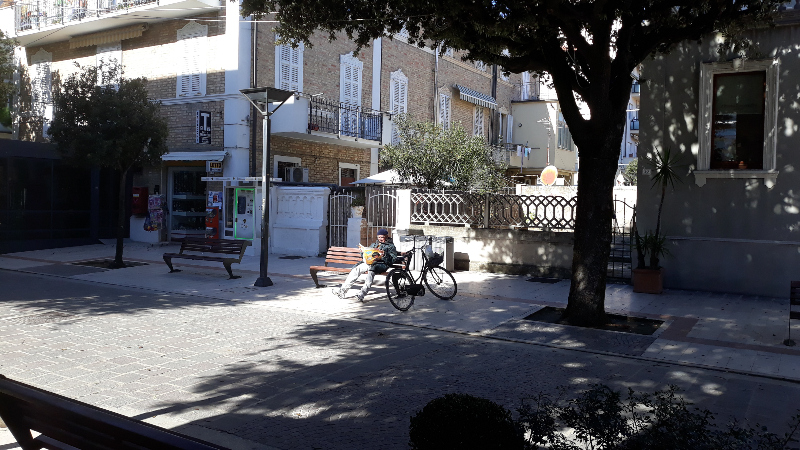
The Italian region of Marche has a coastline 100 miles long next to the Adriatic Sea and east of Umbria. At least a dozen towns are wedged between the main railroad line and the sea. These towns are enormously popular with Italians and are packed with bars, nightclubs, cafes, pizza places, and restaurants. The latter offer fish in a full range of price points from deep-fried and chips to elegant presentations of freshly caught shellfish on enormous platters. In the summer, crowds can be oppressive; other times of the year these coastal communities are blissfully serene with largely empty beaches lapped by blue/green surf.
Three years ago, when we first encountered these towns, with their radically different seasonal personalities, we were struck by a sort of tawdriness. Most of the shoreline access was cut off. Typically, one had to pay a fee to a private “beach club” for the privilege of entering, using a cabana, and being assigned a spot with an umbrella and beach chairs. (This is still very common along the western coastline of Italy.) In between the rigid rows of beach furnishings lined up on the sand, the buildings were almost shacks – insubstantial structures with big signs intended to attract the attention of vacationing families. A kind of small scale, low-rent version of Atlantic City, if you will.
To our surprise and delight all that has changed in the last two years. Each of the towns has — one by one — decided to create series of connected public spaces. In doing so, they teach us lessons that Seattle could use in regaining connections with the water.
First, they closed down the wood shacks by not extending the leases on the underlying land. For the first year cities were occupied with demolishing many of these structures and creating open, “free” beaches. Now, instead of facing what had been an almost continuous wall of gaudy facades, there are expansive views of the sea and places to sit and lay on without being charged.
But they did not stop there. The next step involved changing the roadway that followed the beachfronts. Previously two-way, fast-moving, and filled with lots of parking, these roads now have been redesigned to include a wide protected bike path. Adjacent to it, broad sidewalks were repaved with stone tiles. Distinctive LED lighting fixtures were added. Benches or ledges were also provided as places to sit and gaze. Occasionally the sidewalks broaden out into piazzas large enough for frequent street markets and free musical concerts — with the sea as the backdrop.

And they went even further. Across the roadway, on the inland side were parking lots and undistinguished buildings that interrupted the continuity of the experience of walking. Some of these have recently been converted to public spaces – often with children’s play areas, water elements, and hardscape surfaces for performances and festivals.
In the town of Porto San Giorgio, these new spaces were coordinated with an older series of parks and small plazas, so that there is now a continuous and growing network of connected spaces as well as traditional, classic fountains that lace through the neighborhoods. Some of the narrow, grid streets have been converted to permit bikes and walkers only, with planters, benches, trees, and café seating spilling out onto the street. Lightweight tent structures expand the available table areas for dining during the summer.
In a span of less than two years, these towns – none of which are wealthy enclaves by any means — have transformed their waterfronts into places that are more livable and gracious. It is notable that one sees many people of all ages now using bikes to move around the historic center. More people come out to stroll, reviving the traditional evening “passeggiata,” with families and lovers strolling along the promenades. I have also noticed a significant increase in the number of people using wheelchairs to reach coffee bars, performances, or just to spend time in the sun or shade.
Seattle has a number of locations that could be ideal for this kind of transformation. Alki Beach is an obvious one. The relentless stream of cars could be discouraged and other forms of movement promoted by strategic changes to the infrastructure, including adding small shuttle buses during the peak summer period. Other Puget Sound cities like Kirkland, Kenmore, Edmonds, and Bellingham all have similar opportunities. Some of them have already taken steps to make their waterfronts less dominated by cars and more accommodative to people on foot and on bikes.
Note: An earlier version of this article was previously published in Public Square, an on-line journal dedicated to illuminating best practices in urbanism and sponsored by the Congress for the New Urbanism.
Discover more from Post Alley
Subscribe to get the latest posts sent to your email.

So many tantalizing articles, Mark. After skimming the titles, I first read the one on why Meloni might not be so bad, then your horrible fear of dentists- (which I share, but now with nitrous oxide- I could care less what he does, and totally worth the extra $100.) Comforting to hear how progressive dentistry is in Italy., and this one on beach access in Italy. Here in Hawaii, all beaches are public and access must be provided. We also outlawed billboards back in the 60’s. A couple things we got right. Looking forward to reading more.